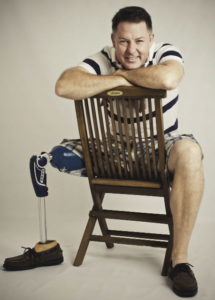
In 2003, while Glenn-Douglas Haig, 52, was celebrating the first night in his new home with friends, three armed robbers entered his home and shot him seven times in the stomach and the right leg. After a five-day coma, Glenn regained consciousness only to find that, due to a severed artery below the knee and ensuing loss of circulation, tissue death, and gangrene, his right leg had been amputated.
However, Glenn did not let this traumatic event dominate his life. Today, Glenn is an accomplished author, teacher, and business coach, who, as he adapted to life after amputation, created his own new beginning. In his writings and teachings, Glenn shares the lessons he has learned as a result of his remarkable, near-death experience.
The following is the story of Glenn’s journey and road to recovery from phantom limb pain (PLP) caused by the amputation of his leg.
Occurrence of phantom limb pain since injury
Glenn has been monitoring and recording the frequency and severity of PLP that he has been suffering following amputation. Changes in weather have always caused PLP, with autumn and spring being Glenn’s „bad seasons“, when he suffered an average of more than ten or twenty episodes a week. In addition to the pain, PLP triggered negative emotive factors such as stress and tiredness (due to being unable to sleep). These factors also created a negative spiral; resulting in further PLP episodes.
The medication and treatments for phantom limb pain that Glenn has tried
Glenn used to take a combination of analgesics and antispasmodics in order to suppress PLP. However, the side effects of the drugs were severe. These included suicidal thoughts and black depression for days afterwards, which deeply affected his quality of life. This made Glenn determined to find a more reliable solution to relieve his PLP.
“Having tried every conceivable treatment for PLP over 16 years (including acupuncture, Trauma Release Therapy, Reiki, Crystals, marijuana oil, a cornucopia of drugs, silver-thread stump covers, various massage techniques, etc), the only viable treatment was the mirror work, which reduced the pains by about 80% – for just over 4 years.” Glenn writes, “Then the effectiveness wore off and the pains returned to their „normal“ frequency and intensity levels.”
Glenn describes his experience with Neuromotus™:
“The experience of working through the Virtual Reality assisted program (Neuromotus™) with a private therapist, Elma Hofmeyer, was at once intense and liberating. It forced me to re-establish my relationship with my body, specifically with my stump, becoming more accepting of the reality of it. My tendency had been to overlook it, to pretend that life could still go on as normal, that I just had to man-up and get on with daily life.
What this process taught me (not including the almost miraculous change in my nervous system’s feedback loop and pain-path „wiring“) was to become equal to the reality of the amputation, to care for my body in a different way, to do simple things like remove my prosthetic at the end of the workday instead of wearing it from bed rise to bedtime, to rub it every evening with gratitude, instead of dismissing it as a bother.
The reduction in pain frequency and intensity is so remarkable that my entire outlook on life has changed. I never realised that I had been depressed and anxious for the past 5-6 years: my body in a constant state of dread and apprehension – until the pains stopped. It has taken me 2 months – and it is still improving on a weekly basis – to TRUST that I am no longer being threatened and so the anxiety levels have dropped, the depression has lifted, and I am far more productive and creative than I have been for the past 17 years. Even my relationship with my partner has improved because I have more energy, enthusiasm and, above all, hope for a pain-free life.
With all respect to you as professionals who are in the business of relieving pain in this world, I thank you”.
While available in Europe, Neuromotus™ is not yet commercially available in the United States.

